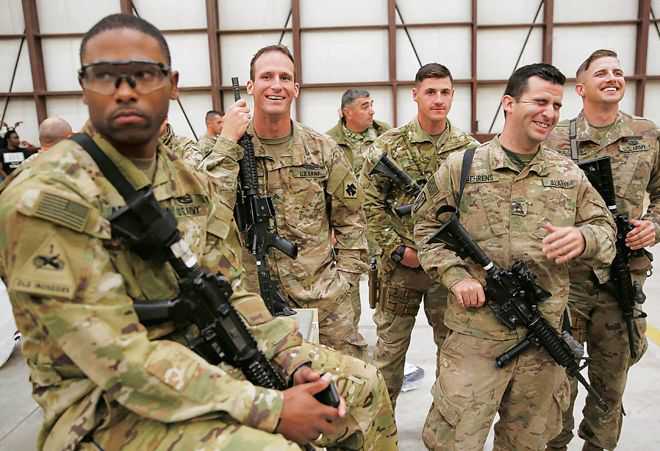
Ominous: With US troops’ withdrawal from Afghanistan, Pakistan gains a double advantage vis-à-vis Kashmir.
Arun Joshi
Senior resident editor, J&K
The withdrawal of US troops from Afghanistan is ominous for Kashmir as it threatens to help the forces of violence that have been looking for such an outcome for years. It spells physical and psychological dangers for India in the Valley, where it has not been able to get a grasp of the problem and solution thereof for decades.
On the physical plane, Kashmir militancy has been forced to shift its original goalpost of translating its nationalistic aspirations, encompassed in the slogan of "azadi" or freedom from "Indian and Pakistani occupation", to Islamic radicalism. The armed militancy has set its eyes on making Kashmir an Islamic republic and that sits well with the Taliban that are enforcing Islamic extremism, backed by bullets and bombs in Afghanistan.
Pakistan — sitting in the geostrategic location between Jammu and Kashmir, India and Afghanistan — is the common source of the troubles in this state, where it has used its terror machinery in Kashmir to bleed India. It has nourished and patronised Taliban in Afghanistan to maintain its strategic depth in the country that has not seen peace since the late 1970s following the Russian invasion.
Taliban to gain
With the US troops heading home, Taliban would expand their gains in Afghanistan where they have already made things tougher for the Afghan government as they control vast swathes of the country. The US troops' challenge to Taliban is over. That adds to the psychological boost of Taliban which are convinced of their invincibility. Psychologically, this Taliban mindset is bound to inspire such Pakistani militant outfits as Lashkar-e-Toiba, Jaish-e-Mohammad in J&K, as also the indigenous Hizb-ul-Mujahadeen.
Afghanistan has been the training ground for Kashmiri militant outfits. In August 1998, when the then US President Bill Clinton ordered missile attacks in Afghanistan in retaliation to Al-Qaida's attacks on the US embassies in Kenya and Tanzania, Kashmiri militant outfits suffered heavy casualties. Pakistan would often train its men and Kashmiri boys in the rugged terrain of Afghanistan to make them battle-ready. These links have grown over the years, with a brief lull in the post-9/11 period when Pakistan came under US scanner.
The Taliban, however, found new life as they regrouped in the FATA area of Pakistan. That made the relationship between Pakistan and Afghanistan important for the US. NATO had made a commitment to get Afghanistan rid of the Taliban. But things changed, with the US and Afghanistan entering into phases of dialogue, an exercise that is turning out to be futile because Pakistan is working to maintain its supremacy with the clear backing of China. With the US military pressure getting lifted in Afghanistan, Pakistan is back to its game of enhancing terror activities in the Valley.
Infiltration from Pak to J&K to rise
Pakistan has gained a double advantage vis-à-vis Kashmir. The US troops' withdrawal from Afghanistan has sent a message that the troops of the superpower can retreat even when its war on terror is far from over. Secondly, it would lift the spirit of militants in Kashmir that if it can happen in Kabul, why not in Kashmir. But the US troops were fighting a war from a distance, assisted with high technology. Kashmir is a different story — for it is historically by virtue of the accession of the state of Jammu and Kashmir to India and there is a direct connectivity between the Valley and the rest of the country.
The fear is that Pakistan would offset this advantage of India in Kashmir by enhancing the level of infiltration from its side to J&K. The infiltration has already picked up, and militants coming from across the LoC are well trained in scaling snow walls as high as 20 feet to cross over to this side. Pakistan would do it more vigorously now and can divert some of the battle-hardened terrorists from Afghanistan to Kashmir, as it had done in the 1990s, to fuel militancy.
Now, this infiltration will have a different connotation because the fear of the Indian army has been diminished — army patrolling parties and convoys are coming under increased attacks not only from armed militants but also stone-throwers who risk their lives to save the militants as also script the narrative that the whole of Kashmir has risen in revolt against India. It would be a mistake to read it as just a south Kashmir phenomenon. It can engulf other parts of the Valley, too.
Pakistan's top leaders, including Prime Minister Imran Khan and Foreign Minister Shah Mahmood Qureshi, have spewed venom against India for what they call Indian atrocities on Kashmiris. Khan has written letters and also dialled UN Secretary-General Antonio Guterres, seeking the world body's intervention in Kashmir in the wake of the December 15 killing of seven stone-throwing protesters who had created a life-threatening situation for the soldiers at an encounter site in Pulwama. Qureshi gave legitimacy to the murderous ideology of Al-Qaida’s offshoot Ansar Ghawatul-Hind after the army killed six of its members in Tral on December 22. It was a day after President Trump ordered the pull-back of US troops from Afghanistan. Qureshi, perhaps, felt emboldened by the US' retreat.
It is a clear incitement to the Kashmiris that they should go in for more violence, defying the laws of the land, create a real-life theatre of confrontation and put India in the dock in Kashmir. This, perhaps, is Pakistan's definition of moral, political and diplomatic support that, in short, means more terrorism, more violence and invitaton to retaliation to repeat Afghanistan in Kashmir.



























